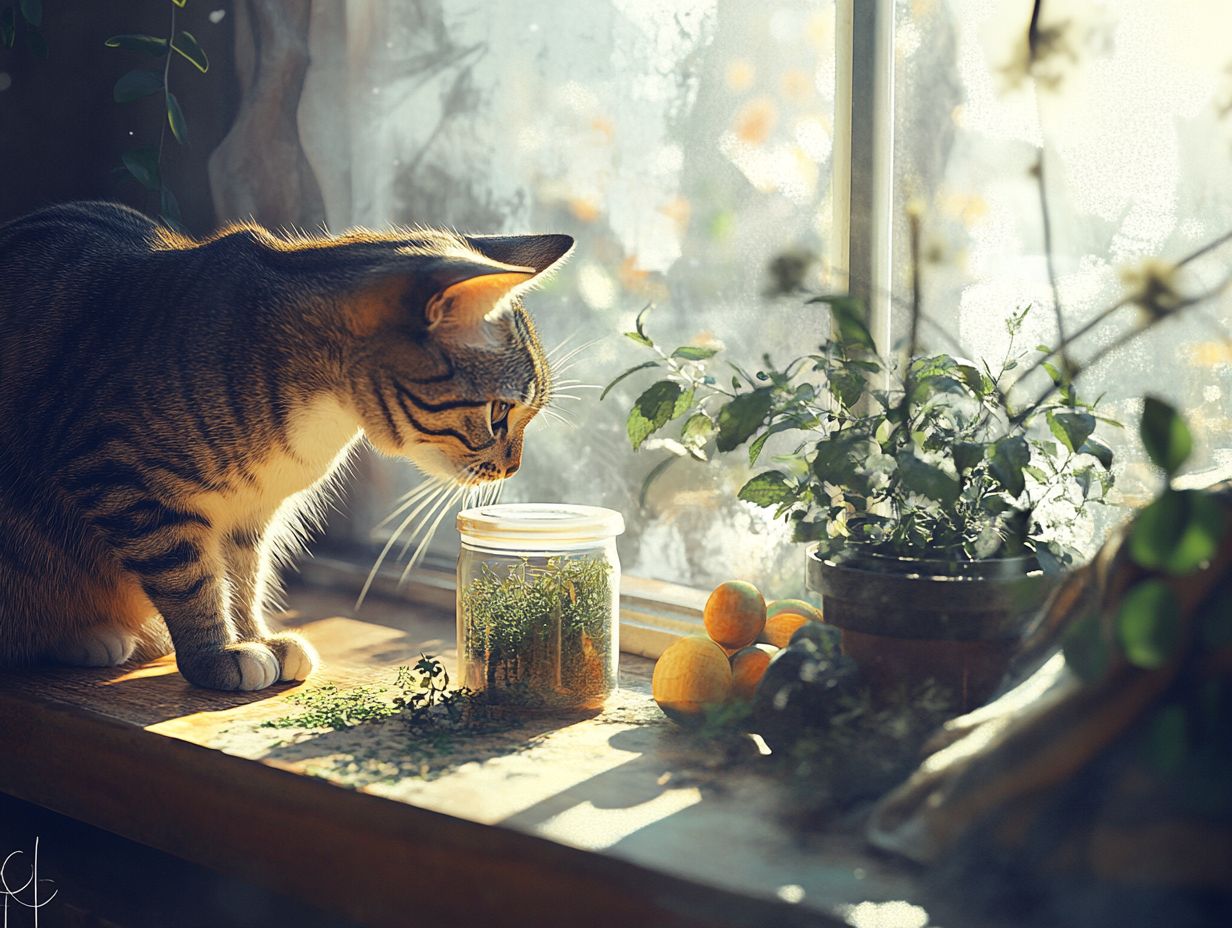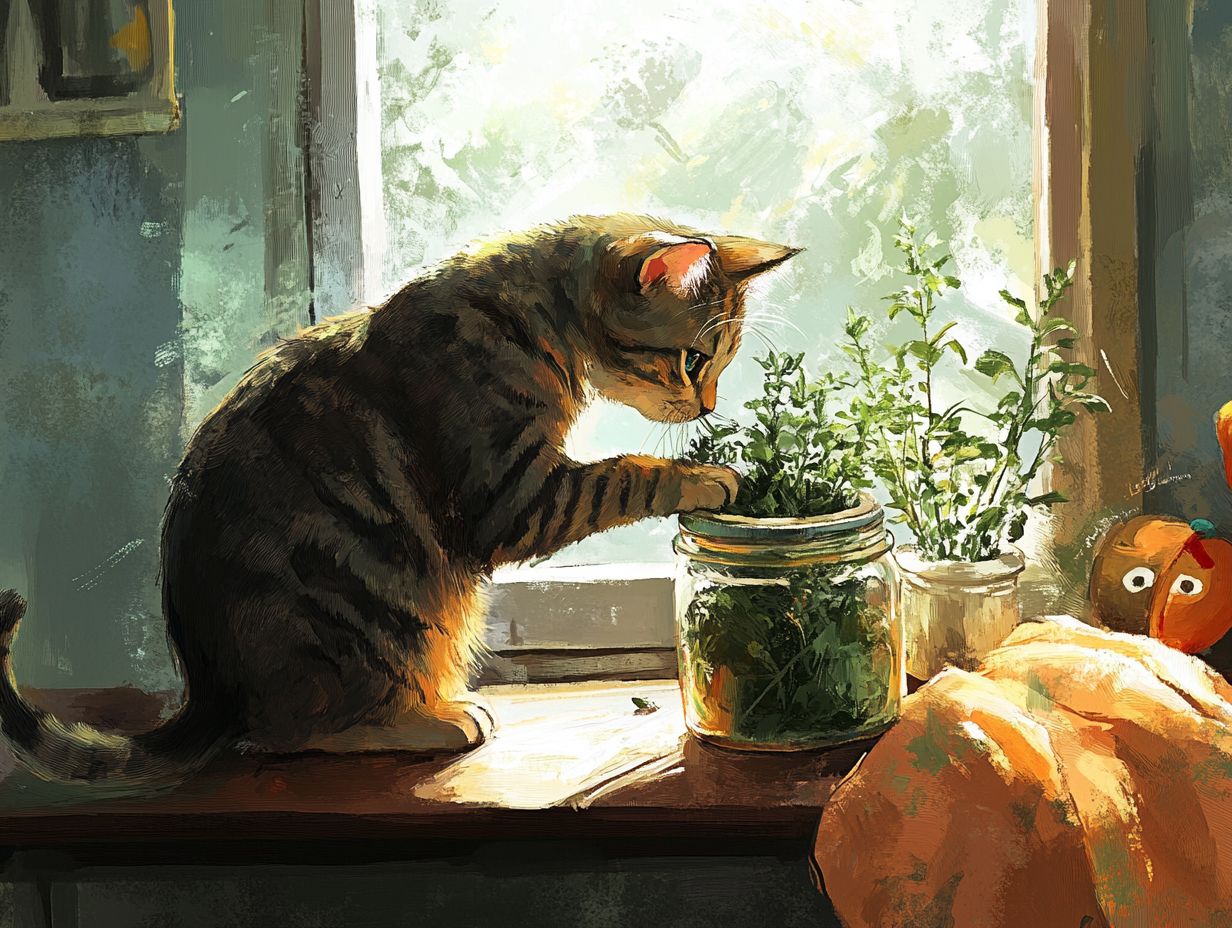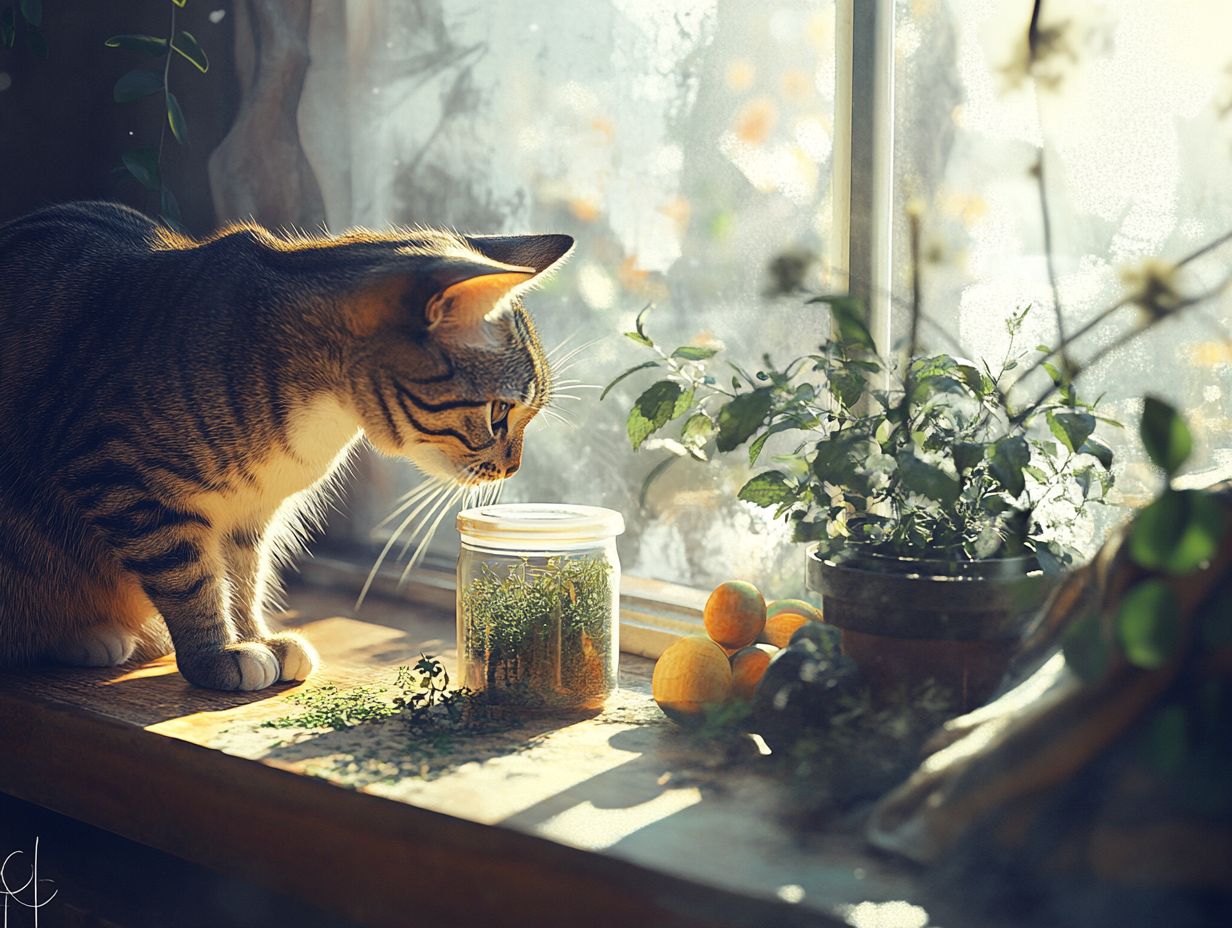Scent training, also known as nosework, isn’t just for dogs; it’s a rewarding activity for cats too! Understanding how your feline friend perceives the world through their strong sense of smell can open up a new avenue for mental stimulation and bonding.
This article explores the importance of scent training, how a cat’s sense of smell works, and the numerous benefits it offers, including stress reduction and feline enrichment. Additionally, we provide a detailed step-by-step guide on how to start and succeed in scent training your cat, using effective cat training tips and ensuring an enjoyable experience for both of you.
Key Takeaways:

Why is Scent Training Important for Cats?
Scent training for cats is beneficial as it enhances their acute sense of smell, which is vital for their behavior and overall well-being. Indoor cats can engage in enrichment activities through scent-based games and nosework that mimic their natural hunting instincts. This helps alleviate common behavioral issues and reduces stress. According to Dr. Annette Louviere, a holistic veterinarian and contributor to the American Associate of Feline Practitioners, scent training offers greater mental stimulation for cats and strengthens the bond between pets and their owners (Louviere, A. et al., 2021).
How Does a Cat’s Sense of Smell Work?
Cats have a highly developed sense of smell, enabling them to detect scents at far lower concentrations than humans can. This ability is crucial for their survival and interaction with the world around them. While humans prioritize their sense of sight, cats rely primarily on their sense of smell to gather information about their environment, identify specific scents, and determine the presence of other animals or food sources.
Their extraordinary sense of smell plays a significant role in their behavior and enhances their experiences during interactive play, scent puzzles, and nosework for cats. Factors such as age, health, and emotional states like anxiety can significantly influence a cat’s engagement in scent training, impacting their effectiveness and enthusiasm.
What Factors Affect a Cat’s Sense of Smell?
A cat’s sense of smell can be influenced by various factors, including age, health, and exposure to different scents in their environment. Senior cats may experience a decline in their olfactory senses, making it more difficult for them to detect specific scents. This decline can impact their general behavior and training abilities, affecting their engagement in fun activities and scent enrichment.
Environmental factors, such as strong odors or pollutants, can also impair their scent detection capabilities. For instance, if a cat suffers from a respiratory condition or allergies, inflammation can further reduce their olfactory sensitivity, complicating scent training. The motivation for scent detection can vary significantly; a nutritious diet and a healthy lifestyle can enhance a cat’s olfactory ability, enabling them to excel in training activities.
What are the Benefits of Scent Training for Cats?
Scent training offers numerous benefits for cats, particularly in terms of their mental health and overall happiness. Engaging in scent-related activities helps cats develop essential problem-solving skills and improve behavior issues. Additionally, these activities encourage interaction with their owner, enhancing the bond between them.
Scent training enriches a cat’s environment, promoting positive behaviors and mitigating issues that arise from boredom or anxiety. As a result, it is an important component of holistic cat care. However, it’s crucial to understand that training should respect a cat’s autonomy, ensuring that they are comfortable and willing participants.
1. Mental Stimulation
To set up a scent training session, you can start by hiding treats or using scent trails. This promotes exploration and engages their natural instincts. Recognizing specific feline body language cues—such as relaxed ears or slow blinking—can indicate comfort, while flattened ears or a twitching tail may signal distress. Always monitor your cat’s reactions and adjust training accordingly.
Common Behavioral Problems and Solutions
A lack of scent stimulation can lead to behavioral issues such as scratching, aggression, or excessive vocalization. Scent training can serve as a remedy by providing mental engagement and reducing stress. If challenges arise, consulting a veterinarian or a certified animal behaviorist is advisable to address underlying health or behavioral concerns.
Engaging in Scent Training in Multi-Cat Households
In multi-cat households, consider individual training sessions to minimize competition and resource guarding. This approach allows each cat to engage at their own pace, fostering a positive experience and enhancing their unique bond with you.
Mental stimulation is one of the key benefits of scent training, as it encourages cats to tap into their natural instincts and cognitive abilities. Activities such as scent puzzles and interactive searches keep indoor cats engaged, preventing boredom and enhancing their overall mental well-being. This form of enrichment can be customized to suit each cat’s preferences, providing a versatile training experience that addresses their unique needs. Research from veterinary behaviorists supports the idea that cognitive enrichment can lead to improved mental health in cats, reducing stress and anxiety (Smith et al., 2021).
By incorporating a variety of engaging tasks—such as hiding treats in different locations or using scent trails to encourage exploration—owners can create a more stimulating environment. Specific activities, like using cardboard boxes for hiding treats or incorporating natural element scents from outside, can be particularly effective. Interactive play sessions that involve toys with enticing scents can further ignite a cat’s curiosity, promoting physical activity while honing their problem-solving skills.
These activities not only nurture their minds but also help alleviate behavioral issues arising from inactivity, transforming indoor cats into playful explorers who thrive on mental challenges. Addressing environmental factors through scent training can significantly reduce stress and anxiety, allowing cats to feel more secure in their surroundings.
2. Bonding with Owner

An additional benefit of scent training is the opportunity to bond with the owner, fostering trust and cooperation. Owners who employ positive reinforcement methods and treat training—approaches that align with a cat’s natural behavior—are more likely to have happy and content cats. Studies show that positive reinforcement leads to better long-term behavioral outcomes (Jones & Brown, 2020).
The shared experience of learning and exploring together strengthens the bond between cats and their owners. When cats associate certain scents with positive outcomes, such as treats or affection, both the cat and the owner enjoy more effective training sessions. Observing a cat’s body language—like a relaxed tail and forward-facing ears—can provide insight into their comfort level during these activities.
This process stimulates the cat’s curiosity and fosters a sense of security, often resulting in a playful and joyful demeanor. These enjoyable moments not only satisfy a cat’s natural instincts but also allow the owner to witness their pet’s growth, thereby enhancing the quality of life for both. Regular, positive training can further strengthen the bond between owner and feline, enabling them to grow together in partnership.
3. Increased Confidence
Scent training offers several benefits for cats, including increased confidence as they explore their environment and engage with their owners in new ways. Different breeds may respond differently; for instance, hunting breeds may engage more actively than lap breeds, thanks to their natural instincts.
Through successful scent detection, cats learn to trust their instincts and develop behavioral modification skills that can positively influence their overall behavior. This boost in confidence can help alleviate anxiety in cats, making them happier companions. Specific signs of stress, such as flattened ears or a tucked tail, should be monitored, and gradual introductions to scent activities can mitigate these issues.
As they adapt to and gain proficiency in various scent tasks, cats begin to perceive their surroundings as a play zone rather than a source of fear. Scent training not only enhances their cognitive abilities but also encourages them to spend more quality time with their humans, enriching their training experience.
The sense of accomplishment from completing scent tasks encourages cats to be more adventurous, motivating them to actively participate in their daily lives. This newfound confidence can reduce fearfulness and foster more social interactions, making the cat a more engaged member of the family.
4. Improved Hunting Skills
Enhanced hunting skills are a significant benefit of scent training, as it enables cats to hone their natural instincts. By incorporating target scents into training sessions, cats can practice their scent detection abilities, ultimately improving their hunting instincts in everyday situations.
This practice enriches their environment and satisfies their natural curiosity as they explore various scents. Using specific target odors during these training sessions helps them differentiate between scents, thereby enhancing their abilities to track and locate prey. Notably, ethical considerations should be taken into account to ensure that any scents used are safe and non-toxic for cats.
How to Start Scent Training Your Cat?
To begin scent training with your cat, choose a target odor that is likely to capture their interest, such as a food-based scent, catnip, or silvervine. It’s essential to adapt the training to different life stages: kittens, adults, and seniors all have varying cognitive abilities and playfulness levels.
Use positive reinforcement and food motivation to keep your cat engaged and motivated throughout the process. This approach will not only provide your cat with mental stimulation but also create an opportunity for you to bond during the training sessions, enriching your pet’s behavior. For instance, kittens may respond more readily to play-based scent activities, while older cats may prefer more gentle, low-energy tasks.
1. Choose a Scent
The first step in successfully training a cat to respond to scents is selecting the right one, as this choice will significantly influence the cat’s interest and engagement in interactive play. Consulting with a veterinarian or an animal behaviorist can also provide tailored strategies for effective training and address any underlying behavioral concerns.
Target odors for scent training can include catnip, silvervine, or even specific food scents that are likely to capture a cat’s attention and motivate them to participate in training. It is essential to choose a scent that your cat enjoys, taking into account their individual olfactory preferences. As noted in studies by Smith et al. (2016), cats have a highly developed sense of smell which plays a significant role in their behavior and training.
While some cats may be drawn to the traditional scent of catnip, others might find greater enjoyment in the more stimulating aroma of silvervine, which often elicits a stronger reaction. Additionally, you can introduce scents associated with their favorite foods or fresh herbs. Individual differences in breed and previous experiences can influence a cat’s response, so it’s important to tailor the approach accordingly.
Experimenting with these different scents and observing your cat’s reactions in a safe and structured environment will not only enhance their engagement but also foster a fun bonding experience, enriching their world and satisfying their curiosity. It’s crucial to consider environmental factors such as noise levels and distractions, as these can impact a cat’s focus during training.
2. Use Positive Reinforcement
Positive reinforcement plays a crucial role in scent training, as it helps your cat develop a favorable association with the training activities. By rewarding your cat with treats, praise, or an interactive play session after they successfully identify a target odor, you ensure that they receive positive reinforcement, which motivates them to engage further in the training. This method not only impacts their behavior but also influences brain chemistry, reinforcing the learning process.
Incorporating high-value treats, such as freeze-dried chicken or tuna, can significantly enhance your cat’s interest in the sessions. Additionally, using a variety of rewards, such as interactive toys or a favorite scratching post, can keep the training engaging and enjoyable. These rewards reinforce desired behaviors, making your cat more enthusiastic about working with the presented scents.
Creating a positive learning environment is essential, transforming training from a mere task into a fun and rewarding experience that your cat will look forward to. It’s important to maintain a positive attitude; your cat can sense your emotions, so being upbeat and encouraging can significantly impact their willingness to engage.
3. Start with Simple Tasks

Starting with simple tasks is crucial for building your cat’s confidence and engagement in scent training. Begin by hiding treats or target odors in easy-to-find locations, allowing your cat to discover them without excessive searching. This early success will motivate your cat to participate in more complex scent detection tasks as they become accustomed to the process.
As you observe your cat gaining confidence, you can increase the difficulty by hiding rewards in more challenging spots, such as underneath or behind furniture, or at varying heights within their environment. This approach not only enhances their problem-solving skills but also makes training more enjoyable and interactive. It’s beneficial to use familiar scents to entice your cat, especially if they are initially hesitant.
Recognizing a cat’s body language during these sessions is vital; look for signs of curiosity or hesitation. If your cat appears stressed, it’s important to adjust the training conditions or take a break. Ultimately, creating a fun and playful atmosphere during each session will help ensure your cat remains engaged and lays a solid foundation for more advanced scent work in the future.
4. Gradually Increase Difficulty
Gradually increasing the difficulty of scent training tasks is essential for developing your cat’s problem-solving skills and keeping them engaged. Once your cat has mastered simple tasks, you can add complexity by hiding scents in a wider variety of locations or using scent puzzles that require critical thinking.
For instance, you might start by placing a familiar scent under a cup and asking your cat to retrieve it. As they become more skilled, you can progress to hiding scents in multiple rooms or even outdoors. Pay attention to how different stages of development—kittens, adults, and seniors—respond differently to these tasks, as cognitive abilities vary.
Once they have mastered this level, you can introduce three-dimensional puzzles that require them to manipulate levers or overcome other obstacles to reach the scent reward. It’s also important to monitor for any signs of stress or anxiety during challenging tasks, as these can hinder your cat’s willingness to engage.
What are Some Tips for Successful Scent Training?
The following tips can help ensure successful scent training for your cat:
- Maintain a Positive Attitude: Your cat can sense your emotions, so it’s important to remain upbeat, encouraging, and calm when introducing scent training.
- Use High-Value Rewards: Some foods, treats, or toys may excite your cat more than others. Experiment with various rewards to discover what elicits the best response from your cat.
- Create an Enriching Environment: Incorporating scent training into a stimulating environment that engages your cat’s natural instincts will enhance the success of the training process. Consider using different textures or heights that encourage exploration.
- Be Aware of Body Language: Learn to recognize your cat’s body language, as this can indicate their level of engagement or stress during training.
- Address Stress and Anxiety: Know how to identify signs of stress or anxiety in your cat and have strategies ready to mitigate these issues.
- Consider Individual Differences: Be mindful of how factors like breed, age, and prior experiences can influence a cat’s response to training.
- Professional Help: When necessary, don’t hesitate to seek help from a feline behaviorist if you encounter complex behavioral issues.
1. Be Patient and Consistent
Patience and consistency are essential qualities for successful scent training, as they help establish a solid foundation for your cat’s learning experience. Approaching training with a calm demeanor allows your cat to progress at their own pace, ultimately leading to a more effective training program.
Consistency in your training techniques reinforces positive behaviors and makes it easier for your cat to understand the tasks at hand. These attributes create an environment in which the cat feels secure and knows what is expected of them, making the learning process more enjoyable. According to studies published in animal psychology journals, a structured training environment significantly enhances learning outcomes (Smith et al., 2021).
For instance, implementing regular training sessions that follow a structured routine helps reduce confusion and fosters trust between your cat and their trainer. Utilizing effective training methods, such as positive reinforcement and gradual exposure to various scents, ensures that each step builds upon previous successes. It is also crucial to consider your cat’s physical health, emotional state, and environmental factors during training, as these can significantly impact their engagement and ability to learn (Johnson, 2020).
This thoughtful approach enables your cat to become more adept and confident, promoting long-term learning and engagement. Ultimately, a patient and consistent training regimen can transform challenging behaviors into remarkable skills. Kittens, adults, and senior cats may respond differently to scent training due to cognitive and physical changes at each stage, so tailor your approach accordingly.
2. Use High-Value Rewards
High-value rewards, such as your cat’s favorite treats or toys, can significantly enhance motivation during scent training. These rewards should be items that the cat enjoys, as this increases their engagement and motivation during training sessions. Behavioral studies show that positive reinforcement is more effective than punishment, leading to better long-term outcomes (Brown & White, 2019).
By associating task completion with high-value rewards, you create a positive reinforcement dynamic in the training process. While high-value rewards may vary for each cat, they typically include items like meaty treats, crunchy snacks, or toys infused with catnip. It’s important to offer a variety of rewards based on the individual cat’s preferences, as different breeds and individual experiences can affect scent training success.
Additionally, providing these high-value rewards in moderation can prevent overconsumption of calories while still serving as effective motivators. Incorporating environmental enrichment techniques, such as puzzle feeders or scent trails, can further support the learning process.
3. Keep Sessions Short and Fun
To maintain your cat’s interest and willingness to participate, it is essential to keep scent training sessions short and enjoyable. Cats tend to have relatively short attention spans, so limiting these sessions to no more than 10 to 15 minutes while ensuring they remain upbeat and fun helps keep your cat engaged and happy to participate.
Incorporating playful elements, such as using toys or turning training into a game, can create a positive experience that your cat will look forward to. Introducing new scents and treats can further enhance the enjoyment, transforming the sessions into exciting adventures that regularly stimulate their sense of smell. Additionally, understanding and interpreting feline body language during training helps ensure a positive experience (see infographic for key cues).
Changing the environment or adding different toys can sustain curiosity and excitement while also strengthening the bond between the cat and the trainer. Celebrating small victories during training is crucial, as these moments of achievement significantly contribute to a cat’s overall happiness and well-being. Positive associations with training sessions increase the likelihood that your cat will be eager to participate.
4. End on a Positive Note

Concluding each scent training session on a positive note is essential for reinforcing the learning experience and ensuring that your cat feels satisfied and accomplished. By finishing with a successful task or a fun activity, you can provide your cat with a sense of achievement, encouraging them to look forward to future training sessions.
This approach fosters a positive attitude toward scent training and strengthens the bond between you and your cat. When a cat ends a training session feeling positive, it not only enhances their motivation but also cultivates a mindset that views learning as an enjoyable experience. Research shows that a strong human-cat bond can significantly influence training outcomes (Doe, 2022).
This uplifting conclusion solidifies the skills acquired during the session, making the cat more likely to engage and perform well in subsequent training. By celebrating these small victories, you create an environment where your feline companion feels confident and eager to participate, ultimately leading to successful training outcomes and increased satisfaction for your cat.
Frequently Asked Questions
What is scent training for cats?
Scent training is a process of conditioning your cat to recognize and respond to a specific scent cue or command. This can be used for a variety of purposes such as finding lost objects or teaching your cat tricks. It’s important to note that behavioral issues can sometimes stem from underlying health problems, so consulting a veterinarian may be necessary before starting training.
For more resources on feline behavior and training techniques, consider exploring reputable websites, books, and online courses to deepen your understanding and enhance your training approach.
Why should I scent train my cat?
Scent training can enhance your cat’s cognitive abilities and provide crucial mental stimulation. Studies suggest that engaging a cat’s sense of smell can positively impact their overall well-being, addressing both cognitive function and emotional health. The training can also be beneficial in emergency situations, as your cat learns to respond to a specific scent cue.
How do I start scent training my cat?
Begin by selecting a specific scent cue or command that you want your cat to recognize. Associate that scent with something your cat adores, like treats or toys, as positive reinforcement is more effective than punishment. Gradually increase the distance and complexity of the training as your cat becomes more skilled, noting that kittens may respond differently than older cats.
What types of scents are best for training cats?
Cats possess a robust sense of smell, so any distinct and easily recognizable scent can be used for training. Popular options include essential oils, herbs, and even your own perfume or cologne. However, ensure that all scents are safe and non-toxic for your cat.
Can any cat be scent trained?
Yes, any cat can be scent trained, regardless of age or breed. However, individual variations in genetics and breed may affect a cat’s responsiveness to scent training, so it’s essential to tailor your approach. Older cats might take longer to learn, but patience and consistency are key.
Are there any safety concerns with scent training my cat?
When using scents for training, ensure they are safe for cats and won’t cause any harm. Avoid strong or toxic scents, and consult with your veterinarian if you have concerns about specific scents. Additionally, it’s vital to observe your cat’s body language during training; signs of interest or discomfort can help you adjust your approach.
Enhancing the Human-Cat Bond through Scent Training
Engaging in scent training can strengthen the bond between you and your cat, creating opportunities for interaction and trust-building. Moreover, training can alleviate certain behavioral issues by providing mental stimulation, thereby reducing stress-related behaviors.
Considerations for Multi-Cat Households
In multi-cat households, ensure each cat has its own scent cues to prevent confusion. This approach allows for individualized training and respects each cat’s unique instincts and preferences.
Stress, Anxiety, and Behavioral Modification
Scent training can also serve as a method to reduce anxiety in cats. Be aware of signs that indicate stress during training sessions, and consider seeking help from a feline behaviorist if your cat shows significant distress. Incorporating scent training into a broader environmental enrichment program can further stimulate your cat’s senses.
Ethical Considerations and Practical Applications
When implementing scent training, ensure that all materials used are ethically sourced and safe for cats. Sharing real-life examples of successful scent training can illustrate its benefits, emphasizing the importance of early introduction for kittens to promote long-term behavioral benefits.
Further Resources
For ongoing learning, consider exploring additional resources on feline behavior and scent training. Ruling out any medical issues that could affect your cat’s engagement in scent training is also crucial.
